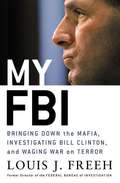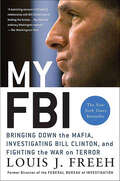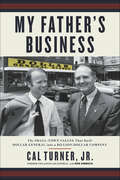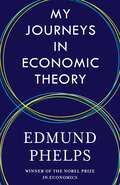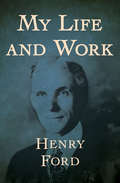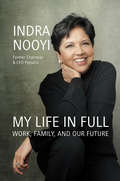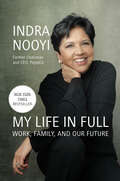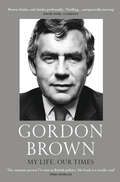- Table View
- List View
My Dream of Stars: From Daughter of Iran to Space Pioneer
by Homer Hickam Anousheh AnsariIn her heartwarming and empowering memoir, space pioneer Anousheh Ansari tells the story of her childhood in Iran and her family's exodus to America after the Islamic Revolution. After settling down in Texas, Anousheh built a computer technology firm from the ground up, which eventually realized a net worth of $750 million and ultimately allowed her to achieve her childhood dream of spaceflight. In her groundbreaking role as the first-ever female commercial spaceflight participant, her story became politicized and fraught with the prejudices and obstacles she had to overcome as an Iranian woman, culminating in a debate over whether she would be allowed to display both the American and Iranian flags on the sleeve of her spacesuit. After her return to Earth, Anousheh started The Ansari Foundation, a quickly growing nonprofit which supports social entrepreneurship, and is especially committed to ensuring the freedom of women around the world and supporting female entrepreneurs. Ultimately, this evocative story shows the triumph of a woman who has become a role model to people around the globe struggling to overcome economic and cultural barriers, as well as those dreamers who look upon the stars and wish to soar among them.
My FBI: Bringing Down the Mafia, Investigating Bill Clinton, and Fighting the War on Terror
by Louis J. FreehFrom his Catholic upbringing, through his jobs as a US attorney and a Federal judge, Freeh was the most hands-on director in FBI history.
My FBI: Bringing Down the Mafia, Investigating Bill Clinton, and Fighting the War on Terror
by Louis J. FreehA spectacular New York Times and Washington Post bestseller, My FBI is the definitive account of American law enforcement during the Clinton years and in the run-up to September 11. Louis Freeh is clear eyed, frank, the ultimate realist, and he offers resolute vision for the struggles ahead.Bill Clinton called Freeh a "law enforcement legend" when he nominated him as the Federal Bureau of Investigation Director. The good feelings would not last. Going toe-to-toe with his boss during the scandal-plagued ‘90s, Freeh fought hard to defend his agency from political interference and to protect America from the growing threat of international terrorism. When Clinton later called that appointment the worst one he had made as president, Freeh considered it "a badge of honor." This is Freeh's entire story, from his Catholic upbringing in New Jersey to law school, the FBI training academy, his career as a US District attorney and as a federal judge, and finally his eight years as the nation's top cop. This is the definitive account of American law enforcement in the run-up to September 11. Freeh is clear-eyed, frank, the ultimate realist, and he offers resolute vision for the struggles ahead."[Freeh] comes off as the real deal, an honorable, hard-working man, a devoted public servant and father, a gifted lawyer and onetime federal prosecutor."---The New York Times
My Father's Business: The Small-Town Values That Built Dollar General into a Billion-Dollar Company
by Cal Turner Rob SimbeckThe first-person account of the family that changed the American retail landscape that Dave Ramsey calls a must-read.Longtime Dollar General CEO Cal Turner, Jr. shares his extraordinary life as heir to the company founded by his father, Cal Turner, Sr., and his grandfather, a dirt farmer turned Depression-era entrepreneur. Cal's narrative is at its heart a father-son story, from his childhood in Scottsville, Kentucky, where business and family were one, to the triumph of reaching the Fortune 300 -- at the cost of risking that very father/son relationship. Cal shares how the small-town values with which he was raised helped him guide Dollar General from family enterprise to national powerhouse. Chronicling three generations of a successful family with very different leadership styles, Cal Jr. shares a wealth of wisdom from a lifetime on the entrepreneurial front lines. He shows how his grandfather turned a third-grade education into an asset for success. He reveals how his driven father hatched the game-changing dollar price point strategy and why it worked. And he explains how he found his own leadership style when he took his place at the helm -- values-based, people-oriented, and pragmatic. Cal's story provides a riveting look at the family love and drama behind Dollar General's spectacular rise, pays homage to the working-class people whose no-frills needs helped determine its rock-bottom prices, and shares the life and lessons of one of America's most compelling business leaders.
My Fire's Gone Out!: How to Cope With Change in Your Work and Life
by Liam O'ConnellA contemporary motivational book – the new “Who Moved My Cheese!”Read it in an hour and change your life for good!Deals with coping with change. This book portrays the fire as a metaphor for what is really important to you in your life or your work. It shows how change happens and how you should react positively and take action and the opportunity that change brings.My fire’s gone out! is a simple, funny and yet profound story about coping with change.The fire is a metaphor for what is really important to you in your life or your work.In this fast-paced modern world we live in,we are faced with many challenges and complex choices. Sometimes our personal fire can go out and this book can help you get that spark back to relight your fire!Thoughts from the flames!• Change happens• React positively• Take action and the opportunity that change bringsMy fire’s gone out! can be applied to any type of change, from redundancy to starting a new relationship. It covers the universal themes of common sense and the reality of life in general!This book can... help you achieve positive success and enjoy your life and your work!
My Fire's Gone Out!: How to Cope With Change in Your Work and Life
by Liam O'ConnellA contemporary motivational book – the new “Who Moved My Cheese!”Read it in an hour and change your life for good!Deals with coping with change. This book portrays the fire as a metaphor for what is really important to you in your life or your work. It shows how change happens and how you should react positively and take action and the opportunity that change brings.My fire’s gone out! is a simple, funny and yet profound story about coping with change.The fire is a metaphor for what is really important to you in your life or your work.In this fast-paced modern world we live in,we are faced with many challenges and complex choices. Sometimes our personal fire can go out and this book can help you get that spark back to relight your fire!Thoughts from the flames!• Change happens• React positively• Take action and the opportunity that change bringsMy fire’s gone out! can be applied to any type of change, from redundancy to starting a new relationship. It covers the universal themes of common sense and the reality of life in general!This book can... help you achieve positive success and enjoy your life and your work!
My First Year as a Teacher: Twenty-Five Teachers Talk About Their Amazing First-Year Classroom Experiences
by Pearl Rock KaneThis inspiring book features 25 touching, hilarious, eye-opening, and true tales about the most frustrating, intimidating, underpaid, and wonderful job in the world. In schools across America, in classes for handicapped, gifted, privileged, and disadvantaged students, these teachers recall that exciting first year, when they were often given the toughest kids and the biggest responsibilities of their careers. <p><p>From coping with inner-city diversity to challenging poor self-esteem, these extraordinary images come straight from people who have already taken those first courageous steps of the novice educator. For anyone who is contemplating teaching as a profession, this invaluable collection is a must-read. "Vivid, poignant, and often funny stories about one of the most challenging experiences anyone can have: first-year teaching."--Albert Shanker, President, American Federation of Teachers
My Greek Drama
by Gianna Angelopoulos-DaskalakiA unique perspective on the politics of Greece -- One of the most popular and revered women in Greece, the author -- Gianna as she is known to millions -- has helped lead her country for decades. Equally poised among and a personal friend of heads of government, royals, and financial leaders, she has an insiders understanding of the current Greek crisis and its potential impact on the worlds economy. As founder of the Angelopoulos Global Public Leaders Program at Harvards John F Kennedy School of Government and as a high-profile participant in the Clinton Global Initiative, the author is a well-respected opinion leader on the international stage. A story of politics, romance, and redemption -- Born to a middle class family on the island of Crete, Gianna describes how her upbringing provided her with the strength and determination she needed to succeed in the male-dominated world of Greek politics and business. After building her own law practice, she leaped into the rough-and-tumble world of governance, where she spearheaded educational reform as an Athens city councilwoman and quickly rose to a position of national prominence as a member of the Hellenic Parliament. Her marriage to one of the worlds richest businessmen was her entree into a world few people have ever experienced. That world has allowed her to understand how power really works and how to overcome adversity to achieve something truly great. A first-hand view of the political games behind hosting the Olympics -- Gianna led her countrys efforts both to bid for and to host the Athens 2004 Summer Olympic Games, an event that the head of the International Olympic Committee described as unforgettable dream games. She reveals, however, that the reality of putting together the games was a nightmare. It took a herculean effort to overcome political bickering, bureaucratic intransigence, and international intrigue and deliver an event that truly honoured the heritage of the games. Never before or since have the Greek people come together in such unifying self-sacrifice -- an effort Gianna insists is needed for Greece to survive the current crisis.
My Hope for Peace
by Jehan SadatFrom the former First Lady of Egypt, New York Times best-selling author, crusader for women's rights, and widow of the slain Nobel Peace Prize winner Anwar Sadat, comes a timely, clear-eyed examination of the defining issues of the Middle East.teps that will lead to their resolution. With a wit and charm developed over fifty years in the public eye, Mrs. Sadat draws on her personal experiences, from her career as first lady of Egypt to her further and yet greater commitments to peace in her widowhood, to explain plainly and frankly the historical, political, and religious underpinnings of the peace process, which many in the West have yet to understand. Along the way, she outlines the origins of modern Islamic terrorism, something she has confronted both politically and personally; she addresses the attendant misconceptions about her faith; and she debunks many of the myths of Muslim womanhood, not least by displaying the clear-eyed passion and political acumen that have earned her worldwide admiration.
My Journey
by Donna KaranIn this candid memoir, renowned designer Donna Karan shares intimate details about her lonely childhood, her four-plus decades in the fashion industry, her two marriages, motherhood, and her ongoing quest for self-acceptance and spiritual peace. Donna Karan was born into the fashion business--her father was a tailor, and her mother was a showroom model and Seventh Avenue saleswoman--yet Karan dreamed of becoming a dancer like Martha Graham or a singer like Barbra Streisand. Fashion was her destiny, though. My Journey traces Karan's early days as an intern at Anne Klein, the creation of her Seven Easy Pieces (which forever changed the way working women dressed), and the meteoric rise of her company. Along with juicy industry stories, Karan candidly discusses her difficult mother and traumatic childhood, her turbulent romantic life, all the loved ones she has lost over the years, and the personal awakening that occurred just as she reached the height of professional and financial success. That awakening set Karan down a path of spiritual discovery and self-improvement. From est to Kabbalah, from silent retreats to leech therapy, Karan tried everything to find, as she writes, "calm in the chaos." But she also reveals how a chaotic life, fueled by endless curiosity and childlike impulses, helped her design seminal collections season after season for global powerhouse brands Donna Karan New York and DKNY. She also details how she has channeled her creativity (and her urge to solve problems and nurture others) into philanthropic work, particularly her early outspoken advocacy for AIDS awareness and research, and the creation of her Urban Zen Foundation, focusing on integrated healthcare and education as well as preservation of culture, which led to her current efforts in Haiti. Karan's life has been crowded with glamorous characters and adventures around the world. But she sometimes still feels like that awkward teen from Long Island who never fit in--which makes her all the more endearing. Brimming with Karan's infectious energy, My Journey is about much more than the fashion world: It is the story of a young woman whose vision and hard work made her a role model for women everywhere--a woman who dreamed big, fought to have it all, broke the rules, and loved passionately along the way.Advance praise for My Journey"Donna's creativity and passion as a committed philanthropist are matched only by her gift for friendship. Whether she's making the world more beautiful or giving a Haitian artisan the tools to create a sustainable business, Donna has always led with great heart and wonderful humor."--President Bill Clinton"What we take for granted often comes from the most revolutionary of sources. In New York in the 1980s, no one was more radical than Donna Karan. She created a way of dressing that was womanly, practical, and empowering."--Anna Wintour "My Journey is the story of an extraordinary personal, professional, and spiritual life. It's a journey defined by Donna's incredible resilience, her inward search for calm in the midst of success, and her insistence on always following her heart."--Arianna Huffington "Anyone who has ever watched Donna Karan in the dressing room with one of her loyal customers has witnessed a bond between designer and client that is as vital as an umbilical cord. That same bond is present on every page of this memoir."--Ingrid Sischy "Donna demonstrates unwavering passion and commitment to women, family, design and all of humanity with her immense philanthropic work. Her story is fascinating!"--Calvin KleinFrom the Hardcover edition.
My Journeys in Economic Theory
by Edmund PhelpsEdmund Phelps is among the most important economists of his generation. He developed a new understanding of unemployment and inflation and went on to rethink the roots of innovation. His work represents a lifelong project to put “people as we know them” into economic theory.In this book, Phelps tells the story of his role in reshaping economic theory, offering a powerful personal account of a creative and rewarding career. My Journeys in Economic Theory charts two major phases of Phelps’s work, illuminating the breadth of his contributions to the field. First, introducing the expectations of wage setters and cofounding the “equilibrium” rate of unemployment, he built the microeconomic foundations for the employment theory pioneered by Keynes and Hicks. More recently, he conceived a theory of “mass flourishing” superseding Schumpeter and Solow’s conception of the process of innovating—a theory in which individuals’ creativity and society’s dynamism fuel grassroots innovation and generate job satisfaction in the process.Phelps recounts his vivid experiences in the world of economics—fierce arguments, competition and collaboration, and the good fortune of time spent among some great figures—as well as his relationships with luminaries such as John Rawls, Thomas Nagel, Paul Samuelson, and Paul Volcker. At its core, this book shares the joy of intellectual achievement: the excitement of coming up with a new idea that radically departs from prevailing views and the satisfaction of exercising one’s own ingenuity instead of applying or developing others’ models. Telling the story of a life packed with intellectual adventure, My Journeys in Economic Theory provides a profound vision of a dynamic, modern economy that offers lives rich with creativity and meaning.
My Korean Deli: Risking It All For a Convenience Store
by Ben Ryder HoweThis sweet and funny tale of a preppy editor buying a Brooklyn deli with his Korean in-laws is about family, culture clash, and the quest for authentic experiences.
My Life and Work: Henry Ford's Autobiography, With A History Of The Ford Motor Company (hardcover)
by Henry FordHenry Ford's classic treatise on life and business Written by the legendary inventor and industrialist who pioneered the American automotive industry, My Life and Work is a unique combination of memoir and business treatise. In straightforward and inviting prose, Henry Ford describes his early life as a mechanically inclined farmer's son, the inner workings of his famed motor company, and the development of the Model T. He provides analysis and commentary on some of his key business decisions, including his resolution to compensate workers well beyond the prevailing wage and his commitment to building a diverse workforce composed of "about the same proportions as a cross-section of a society in general." My Life and Work is an enduring American classic that captures the musings and philosophical considerations of one of the country's greatest visionaries. This ebook has been professionally proofread to ensure accuracy and readability on all devices.
My Life as a Quant
by Emanuel DermanIn My Life as a Quant, Emanuel Derman relives his exciting journey as one of the first high-energy particle physicists to migrate to Wall Street. Page by page, Derman details his adventures in this field--analyzing the incompatible personas of traders and quants, and discussing the dissimilar nature of knowledge in physics and finance. Throughout this tale, he also reflects on the appropriate way to apply the refined methods of physics to the hurly-burly world of markets.
My Life in Food: A Memoir
by Albert RouxIn 2021, the world of cooking lost a legendary figure. Albert Roux, together with his brother Michel, transformed the way we eat, cook and appreciate food in this country. It is no exaggeration to say that most of what makes our current culinary landscape so vibrant began with these two brothers and their ground-breaking restaurant, Le Gavroche.Albert first arrived in England in the fifties, at a time of grey and brown food, with a nation still reeling from the effects of war and rationing. Cooking in the grand private houses of the aristocracy, he was to fall in love with the country and, after his military service, which he spent fighting in the Algerian Civil War, he would eventually make it his home for life. He and his brother set up Le Gavroche in 1967. It was to become the first restaurant in the UK to gain first one, and eventually three, Michelin stars. Together with their other restaurants, including the renowned Waterside Inn in Bray, it would go on to revolutionise the industry. The Roux restaurants set on their course an entire generation of award-winning chefs: his protégés include Gordon Ramsay, Marcus Wareing, Rowley Leigh and Monica Galetti, to name just a tiny fraction. He won every plaudit possible in the world of food, and was granted an OBE, a Chevalier de la Légion d'Honneur, and a papal knighthood.Albert's memoir takes us from his childhood in wartime France, where the ever-looming presence of the German troops made it a challenge for his mother to keep the family fed, right up to the almost instant success of Le Gavroche, which welcomed everybody from royalty - the Queen Mother and Princess Diana were both regulars - to Hollywood legends including Charlie Chaplin. He talks frankly about his famed relationship with his brother, and about the encounter which derailed his first boyhood ambition to join the priesthood. His drive, humour and joie de vivre leap off every page, and the insight into what it took to break new ground in the restaurant industry is unmatched.These are the last words from a pioneer, a hero who inspired entire generations of chefs. They tell the story not only of a titan of a man, but of an era that shaped the way we cook and eat today.
My Life in Food: A Memoir
by Albert RouxIn 2021, the world of cooking lost a legendary figure. Albert Roux, together with his brother Michel, transformed the way we eat, cook and appreciate food in this country. It is no exaggeration to say that most of what makes our current culinary landscape so vibrant began with these two brothers and their ground-breaking restaurant, Le Gavroche.Albert first arrived in England in the fifties, at a time of grey and brown food, with a nation still reeling from the effects of war and rationing. Cooking in the grand private houses of the aristocracy, he was to fall in love with the country and, after his military service, which he spent fighting in the Algerian Civil War, he would eventually make it his home for life. He and his brother set up Le Gavroche in 1967. It was to become the first restaurant in the UK to gain first one, and eventually three, Michelin stars. Together with their other restaurants, including the renowned Waterside Inn in Bray, it would go on to revolutionise the industry. The Roux restaurants set on their course an entire generation of award-winning chefs: his protégés include Gordon Ramsay, Marcus Wareing, Rowley Leigh and Monica Galetti, to name just a tiny fraction. He won every plaudit possible in the world of food, and was granted an OBE, a Chevalier de la Légion d'Honneur, and a papal knighthood.Albert's memoir takes us from his childhood in wartime France, where the ever-looming presence of the German troops made it a challenge for his mother to keep the family fed, right up to the almost instant success of Le Gavroche, which welcomed everybody from royalty - the Queen Mother and Princess Diana were both regulars - to Hollywood legends including Charlie Chaplin. He talks frankly about his famed relationship with his brother, and about the encounter which derailed his first boyhood ambition to join the priesthood. His drive, humour and joie de vivre leap off every page, and the insight into what it took to break new ground in the restaurant industry is unmatched.These are the last words from a pioneer, a hero who inspired entire generations of chefs. They tell the story not only of a titan of a man, but of an era that shaped the way we cook and eat today.
My Life in Full: Work, Family and Our Future
by Indra Nooyi'A must-read for working women and the men who work with us, love us and support us' Hillary Rodham Clinton'Surprising and compelling' Financial TimesThe much-anticipated and inspiring memoir by Indra Nooyi, the trailblazing former CEO of PepsiCo, offering clear-eyed insight and a call to action for how our society can really blend work and family - and advance women - in the twenty-first centuryFor more than a dozen years as one of the world's most admired CEOs, Indra Nooyi redefined what it means to be an exceptional leader. The first woman, person of color, and immigrant to run a Fortune 50 company - and one of the foremost strategic thinkers of our time - Nooyi transformed PepsiCo with a unique vision, a vigorous pursuit of excellence, and a deep sense of purpose. Now, in a rich memoir brimming with grace, grit, and good humor, My Life in Full offers a firsthand view of a legendary career and the sacrifices it so often demanded.In her book, Nooyi shares the events that shaped her - from her childhood in 1960s India, to the Yale School of Management, to her rise as a consultant and corporate strategist who soon ascended into the most senior executive ranks. The book offers an intimate look inside PepsiCo, detailing how she steered the iconic American company toward healthier products and reinvented its environmental profile without curbing financial performance - despite resistance at every turn. At the same time, Nooyi built a home with her husband - also a high-powered executive - two daughters, and members of her extended family. My Life in Full includes her unvarnished take on the competing pressures on her attention and time, and what she learned along the way. This book, as has her personal journey, will inspire young women everywhere to believe that they, too, can climb to powerful roles without giving up on the desire for a family and children. But, as Nooyi eloquently argues, her story is not a call for women to simply try harder, but is proof of the importance of organised care structures in all of our success. Nooyi makes a clear, actionable, urgent call for business and government to prioritise the care ecosystem, from skilled care networks to zoning policy, to paid leave and flexible and predictable work hours, each so critical to unleashing the economy's full potential and helping families thrive.Generous, authoritative, and grounded in lived experience, My Life in Full is both the story of an extraordinary leader's life, and a moving tribute to the relationships that created it.
My Life in Full: Work, Family and Our Future
by Indra Nooyi'A must-read for working women and the men who work with us, love us and support us' Hillary Rodham Clinton'Surprising and compelling' Financial TimesThe much-anticipated and inspiring memoir by Indra Nooyi, the trailblazing former CEO of PepsiCo, offering clear-eyed insight and a call to action for how our society can really blend work and family - and advance women - in the twenty-first centuryFor more than a dozen years as one of the world's most admired CEOs, Indra Nooyi redefined what it means to be an exceptional leader. The first woman, person of color, and immigrant to run a Fortune 50 company - and one of the foremost strategic thinkers of our time - Nooyi transformed PepsiCo with a unique vision, a vigorous pursuit of excellence, and a deep sense of purpose. Now, in a rich memoir brimming with grace, grit, and good humor, My Life in Full offers a firsthand view of a legendary career and the sacrifices it so often demanded.In her book, Nooyi shares the events that shaped her - from her childhood in 1960s India, to the Yale School of Management, to her rise as a consultant and corporate strategist who soon ascended into the most senior executive ranks. The book offers an intimate look inside PepsiCo, detailing how she steered the iconic American company toward healthier products and reinvented its environmental profile without curbing financial performance - despite resistance at every turn. At the same time, Nooyi built a home with her husband - also a high-powered executive - two daughters, and members of her extended family. My Life in Full includes her unvarnished take on the competing pressures on her attention and time, and what she learned along the way. This book, as has her personal journey, will inspire young women everywhere to believe that they, too, can climb to powerful roles without giving up on the desire for a family and children. But, as Nooyi eloquently argues, her story is not a call for women to simply try harder, but is proof of the importance of organised care structures in all of our success. Nooyi makes a clear, actionable, urgent call for business and government to prioritise the care ecosystem, from skilled care networks to zoning policy, to paid leave and flexible and predictable work hours, each so critical to unleashing the economy's full potential and helping families thrive.Generous, authoritative, and grounded in lived experience, My Life in Full is both the story of an extraordinary leader's life, and a moving tribute to the relationships that created it.
My Life in Full: Work, Family, and Our Future
by Indra NooyiAn intimate and powerful memoir by the trailblazing former CEO of PepsiCo For a dozen years as one of the world&’s most admired CEOs, Indra Nooyi redefined what it means to be an exceptional leader. The first woman of color and immigrant to run a Fortune 50 company — and one of the foremost strategic thinkers of our time — she transformed PepsiCo with a unique vision, a vigorous pursuit of excellence, and a deep sense of purpose. Now, in a rich memoir brimming with grace, grit, and good humor, My Life in Full offers a firsthand view of Nooyi&’s legendary career and the sacrifices it so often demanded. Nooyi takes us through the events that shaped her, from her childhood and early education in 1960s India, to the Yale School of Management, to her rise as a corporate consultant and strategist who soon ascended into the most senior executive ranks. The book offers an inside look at PepsiCo, and Nooyi&’s thinking as she steered the iconic American company toward healthier products and reinvented its environmental profile, despite resistance at every turn. For the first time and in raw detail, Nooyi also lays bare the difficulties that came with managing her demanding job with a growing family, and what she learned along the way. She makes a clear, actionable, urgent call for business and government to prioritize the care ecosystem, paid leave and work flexibility, and a convincing argument for how improving company and community support for young family builders will unleash the economy&’s full potential. Generous, authoritative, and grounded in lived experience, My Life in Full is the story of an extraordinary leader&’s life, a moving tribute to the relationships that created it, and a blueprint for 21st century prosperity.
My Life in Leadership
by Jim Collins Frances HesselbeinIn a clear and compelling voice, Frances Hesselbein delivers key leadership lessons. Tracing her own development as a leader, she narrates the critical moments that shaped her personally and professionally: from her childhood in Pennsylvania, to moving up from Girl Scout troop leader to Girl Scout CEO, to founding and leading the Leader to Leader Institute, to her friendships and experiences with some of the greatest leaders and thinkers of our time. Each chapter includes an inspirational story, a key lesson and how to apply it to daily life.
My Life in Red and White: The Sunday Times No 1 Bestseller
by Arsene WengerThere is only one Arsène Wenger - and for the very first time, in his own words, this is his story.In this definitive autobiography, the world-renowned, revolutionary football manager discusses his life and career, sharing his leadership principles for success on and off the field. At Arsenal, Wenger won multiple Premier League titles, a record number of FA Cups, and masterminded the historic 'Invincibles' season of 2003-2004. He changed the game in England forever, popularising an attacking approach and changing attitudes towards nutrition, fitness and coaching methods - and towards foreign managers. The book charts his extraordinary career, from his rise in France and Japan where he managed Nancy, Monaco and Nagoya Grampus Eight - clubs that also play in red-and-white - to his twenty-two years at the helm in north London.A must-read not only for Arsenal supporters but football fans everywhere, MY LIFE IN RED AND WHITE illuminates the mystique surrounding one of the most respected managers in the world's most popular sport.
My Life, Our Times
by Gordon BrownThis revelatory memoir from Britain's former Prime Minister offers vital insights into our extraordinary times.Former Prime Minister and the country's longest-serving Chancellor, Gordon Brown has been a guiding force for Britain and the world over three decades. This is his candid, poignant and deeply relevant story.In describing his upbringing in Scotland as the son of a minister, the near loss of his eyesight as a student and the death of his daughter within days of her birth, he shares the passionately-held principles that have shaped and driven him, reminding us that politics can and should be a calling to serve. Reflecting on the personal and ideological tensions within Labour and its successes and failures in power, he describes how to meet the challenge of pursuing a radical agenda within a credible party of government.From the invasion of Iraq to the tragedy of Afghanistan, from the coalition negotiations of 2010 to the referendums on Scottish independence and Europe, Gordon Brown draws on his unique experiences to explain Britain's current fractured condition. By showing us what progressive politics has achieved in recent decades, he inspires us with a vision of what it might yet achieve.Riveting, expert and highly personal, this historic memoir is an invaluable insight into our times.
My Memories of John Hartford (American Made Music Series)
by Bob CarlinMy Memories of John Hartford is a memoir about author Bob Carlin's years working alongside singer, songwriter, banjoist, and fiddler John Hartford (1937-2001). Throughout his short life, Hartford was a hit tunesmith, festival headliner, and godfather of newgrass music. He also made contributions to the film and television industry as a star in The Smothers Brothers Comedy Hour and The Glen Campbell Goodtime Hour and helped create the soundtrack for O Brother, Where Art Thou?Carlin and Hartford first met when Carlin interviewed the entertainer for Fresh Air with Terry Gross. From this first meeting over microphones developed a sixteen-year affiliation. Six years into their friendship, a working collaboration grew between the two. Carlin first accompanied John Hartford on several albums, eventually becoming his project manager for audio and video recordings. Finally, Carlin was recruited into John Hartford's last Stringband, for which he also served as the de facto road manager and right-hand guy. My Memories of John Hartford opens with an overview of the years before Hartford and Carlin's friendship, then details the last fifteen years of John Hartford's life. Included are in-depth descriptions of Hartford's lifestyle, as well as his philosophies about music, performing, recording, and living as he expressed them to the author or to those around him, with some road stories thrown in for good measure. And, those last fifteen years of his short life, while tempered by available information, are viewed here through the impressionist lenses of the author's own experience.
My Mom, Style Icon
by Piper WeissMoms are people, too...fashionable people! Before we came along to yank on their skirts, they showed leg, sported killer bangs, and flaunted bikinis. Some even wore feathers and halter tops and drove around on motorcycles. Was their style shocking? Yes. Covetable? Absolutely. Based on Piper Weiss's hugely popular blog of the same name, this book features 200 color photographs from decades past of moms showing us how its done. A perfect gift for mothers, daughters, and style mavens, My Mom, Style Icon is an entertaining celebration of the very first—and most important—style icon in a young woman's life.
My Money My Way: Taking Back Control of Your Financial Life
by Kumiko LoveDoes fear and insecurity keep you from looking at your bank account? Is your financial anxiety holding you captive? You don&’t have to stress about money anymore. YOU can take back control. As a newly divorced single mom making $24,000 per year and facing down $77,000 in debt, Kumiko Love worried constantly about money. She saw what other moms had—vacations, birthday parties, a house full of furniture—and felt ashamed that she and her son lived in a small apartment and ate dinner on the floor. Worse, when her feelings began to exhaust her, she binge-shopped, reasoning that she&’d feel better after a trip to the mall. On the day she needed to pay for a McDonald&’s ice cream cone without her credit card, she had an epiphany: Money is not the problem. Self-Doubt is the problem. Shame is the problem. Guilt is the problem. Society&’s expectations for her are the problem. She is the solution. Once she reversed the negative thinking patterns pushing her toward decisions that didn&’t serve her values or goals, her financial plan wrote itself. Now, she&’s not only living debt-free in her dream home, which she paid for in cash, but she has spread her teachings around the world and helped countless women envision better lives for themselves and their families. Now, building on the lessons she&’s taught millions as the founder of The Budget Mom, she shares a step by step plan for taking control back over your financial life—regardless of your level of income or your credit card balance. Through stories from navigating divorce to helping clients thrive through recessions, depression, eviction, layoffs and so much more, you will learn foundational practices such as: • How to use your emotions to your financial advantage, instead of letting them control you • How to create a budget based on your real life, not a life of self-denial • How to create a motivating debt pay-off plan that makes you excited about your future, instead of fearing it My Money My Way will give you the tools to align your emotional health with your financial health—to let go of deprivation and embrace desire. Love&’s paradigm-shifting system will teach you how to honor your unique personal values, driving emotions, and particular needs so that you can stop worrying about money and start living a financially fulfilled life.

